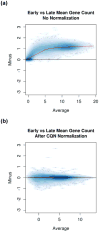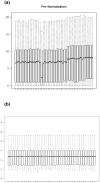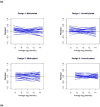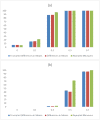Lessons learned in the analysis of high-dimensional data in vaccinomics
- PMID: 25957070
- PMCID: PMC4581898
- DOI: 10.1016/j.vaccine.2015.04.088
Lessons learned in the analysis of high-dimensional data in vaccinomics
Abstract
The field of vaccinology is increasingly moving toward the generation, analysis, and modeling of extremely large and complex high-dimensional datasets. We have used data such as these in the development and advancement of the field of vaccinomics to enable prediction of vaccine responses and to develop new vaccine candidates. However, the application of systems biology to what has been termed "big data," or "high-dimensional data," is not without significant challenges-chief among them a paucity of gold standard analysis and modeling paradigms with which to interpret the data. In this article, we relate some of the lessons we have learned over the last decade of working with high-dimensional, high-throughput data as applied to the field of vaccinomics. The value of such efforts, however, is ultimately to better understand the immune mechanisms by which protective and non-protective responses to vaccines are generated, and to use this information to support a personalized vaccinology approach in creating better, and safer, vaccines for the public health.
Keywords: Data interpretation, statistical; Immunogenetics; Systems biology; Vaccination; Vaccines.
Copyright © 2015 Elsevier Ltd. All rights reserved.
Conflict of interest statement
Figures






Similar articles
-
Vaccinomics, adversomics, and the immune response network theory: individualized vaccinology in the 21st century.Semin Immunol. 2013 Apr;25(2):89-103. doi: 10.1016/j.smim.2013.04.007. Epub 2013 Jun 5. Semin Immunol. 2013. PMID: 23755893 Free PMC article. Review.
-
Personalized vaccinology: A review.Vaccine. 2018 Aug 28;36(36):5350-5357. doi: 10.1016/j.vaccine.2017.07.062. Epub 2017 Jul 31. Vaccine. 2018. PMID: 28774561 Free PMC article. Review.
-
Systems vaccinology: Enabling rational vaccine design with systems biological approaches.Vaccine. 2015 Sep 29;33(40):5294-301. doi: 10.1016/j.vaccine.2015.03.072. Epub 2015 Apr 6. Vaccine. 2015. PMID: 25858860 Free PMC article. Review.
-
High-throughput data analysis and data integration for vaccine trials.Vaccine. 2015 Sep 29;33(40):5249-55. doi: 10.1016/j.vaccine.2015.04.096. Epub 2015 May 11. Vaccine. 2015. PMID: 25976544
-
Heterogeneity in vaccine immune response: the role of immunogenetics and the emerging field of vaccinomics.Clin Pharmacol Ther. 2007 Dec;82(6):653-64. doi: 10.1038/sj.clpt.6100415. Epub 2007 Oct 31. Clin Pharmacol Ther. 2007. PMID: 17971814 Review.
Cited by
-
Current Challenges in Vaccinology.Front Immunol. 2020 Jun 25;11:1181. doi: 10.3389/fimmu.2020.01181. eCollection 2020. Front Immunol. 2020. PMID: 32670279 Free PMC article. Review.
-
Enhancing vaccine safety capacity globally: A lifecycle perspective.Vaccine. 2015 Nov 27;33 Suppl 4(0 4):D46-54. doi: 10.1016/j.vaccine.2015.06.073. Epub 2015 Oct 1. Vaccine. 2015. PMID: 26433922 Free PMC article. Review.
-
System-Wide Associations between DNA-Methylation, Gene Expression, and Humoral Immune Response to Influenza Vaccination.PLoS One. 2016 Mar 31;11(3):e0152034. doi: 10.1371/journal.pone.0152034. eCollection 2016. PLoS One. 2016. PMID: 27031986 Free PMC article.
-
Immunosenescence-Related Transcriptomic and Immunologic Changes in Older Individuals Following Influenza Vaccination.Front Immunol. 2016 Nov 2;7:450. doi: 10.3389/fimmu.2016.00450. eCollection 2016. Front Immunol. 2016. PMID: 27853459 Free PMC article.
-
An interaction quantitative trait loci tool implicates epistatic functional variants in an apoptosis pathway in smallpox vaccine eQTL data.Genes Immun. 2016 Jun;17(4):244-50. doi: 10.1038/gene.2016.15. Epub 2016 Apr 7. Genes Immun. 2016. PMID: 27052692
References
-
- Poland GA. Pharmacology, vaccinomics, and the second golden age of vaccinology. Clin Pharmacol Ther. 2007 Dec;82(6):623–6. - PubMed
Publication types
MeSH terms
Substances
Grants and funding
LinkOut - more resources
Full Text Sources
Other Literature Sources
Medical

